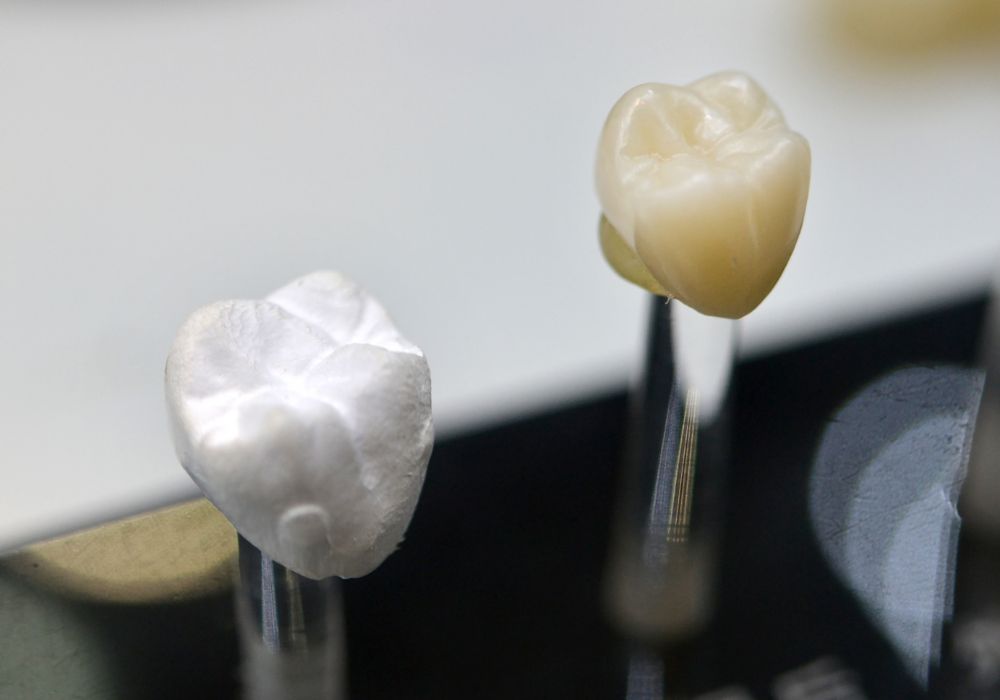Have you ever wondered what keeps a tooth in place after a root canal? Root canal treatment is a common procedure that is performed to save a damaged or infected tooth. During the procedure, the inflamed pulp is removed, and the tooth is filled with a biocompatible material to seal it off from bacteria. But what happens next? How does the tooth stay in place without its pulp?
The answer lies in the periodontal ligament (PDL), a soft tissue union between your teeth and the bone. The PDL is responsible for holding your teeth in place, not the bone or gum tissue as many people believe. The PDL is made up of various collagen types and has a narrow neurovascular component that is essential for the tooth’s stability. After a root canal, the PDL continues to hold the tooth in place, and the body begins the process of healing the affected area by sending in new cells to repair the damage caused by the treatment.
Understanding Root Canal Procedure
If you have been experiencing tooth pain or sensitivity, you may need a root canal procedure. This treatment is designed to remove infected or damaged tissue from inside your tooth, clean the area, and seal it to prevent further damage. Here’s what you can expect during a root canal procedure:
Step 1: Numbing the Tooth
Before the procedure begins, your dentist will numb the area around the affected tooth using a local anesthetic. This will help you feel more comfortable during the procedure and prevent pain.
Step 2: Accessing the Pulp
Next, your dentist will create a small hole in the top of your tooth to access the pulp, which is the soft tissue inside your tooth that contains nerves and blood vessels.
Step 3: Removing the Pulp
Using specialized tools, your dentist will carefully remove the damaged or infected pulp from inside your tooth. This may take some time, depending on the extent of the damage.
Step 4: Cleaning the Area
Once the pulp has been removed, your dentist will clean the inside of your tooth to remove any remaining bacteria or debris. This will help prevent further infection or damage.
Step 5: Sealing the Tooth
Finally, your dentist will fill the inside of your tooth with a special material and seal it to prevent further damage. In some cases, you may need a crown or other restoration to protect the tooth and restore its function.
Overall, a root canal procedure can help relieve pain and save your tooth from further damage. If you think you may need a root canal, talk to your dentist about your options and what to expect during the procedure.
Tooth Anatomy and Structure

Your teeth are complex structures that are made up of different layers. Understanding the anatomy of your teeth can help you appreciate how they work and how they are held in place.
Layers of the Tooth
Each tooth is composed of three main layers: the enamel, dentin, and pulp.
- Enamel: This is the hard, outermost layer of your tooth. It is made up of minerals and is the hardest substance in your body.
- Dentin: This is the layer of the tooth that lies beneath the enamel. It is softer than enamel, but still quite hard.
- Pulp: This is the innermost layer of your tooth. It contains nerves, blood vessels, and connective tissue.
Tooth Structure
Your teeth are held in place by a combination of factors, including the periodontal ligament, cementum, and alveolar bone.
- Periodontal Ligament: This is a thin layer of tissue that surrounds the tooth root and connects it to the alveolar bone. It helps to absorb shock and prevent damage to the tooth.
- Cementum: This is a layer of hard tissue that covers the tooth root. It helps to anchor the tooth in place.
- Alveolar Bone: This is the bone that surrounds and supports the teeth. It is constantly being remodeled in response to the forces placed on the teeth during biting and chewing.
Overall, the combination of these factors helps to keep your teeth firmly anchored in place. However, in some cases, a root canal may be necessary to save a damaged or infected tooth and prevent it from becoming loose or falling out.
Role of Dental Cement in Root Canal
After a root canal treatment, your tooth will need a dental restoration to protect and strengthen it. One of the most important aspects of this restoration is the dental cement used to hold everything in place.
Dental cement, also known as dental adhesive, is a type of material that is used to bond different parts of a dental restoration together. This includes bonding the filling material to the walls of the root canal and bonding the crown or other type of restoration to the tooth.
The dental cement used in root canal treatments is typically a type of resin-based material that is designed to be strong, durable, and long-lasting. It is also biocompatible, which means that it is safe for use in the human body and will not cause any adverse reactions.
One of the key benefits of dental cement is that it helps to create a tight seal between the restoration and the tooth. This prevents bacteria and other harmful substances from getting inside the tooth and causing further damage or infection.
In addition to its sealing properties, dental cement also helps to provide additional strength and support to the tooth. This is especially important for teeth that have undergone a root canal treatment, as they can be weaker and more susceptible to damage.
Overall, dental cement plays a crucial role in the success and longevity of a root canal treatment. By providing a strong and durable bond between the restoration and the tooth, it helps to ensure that the tooth remains healthy and functional for years to come.
Use of Dental Crowns After Root Canal

After undergoing a root canal, your tooth may become brittle and prone to fracture. A dental crown is a common solution to protect and strengthen the tooth after a root canal. A crown is a cap that is placed over the tooth to restore its shape, size, and strength. Here are some things you should know about dental crowns after a root canal:
Why Get a Crown After a Root Canal?
A dental crown is essential after a root canal because it helps to prevent further damage to the tooth. The crown acts as a shield, protecting the tooth from decay, infection, and fracture. Without a crown, the tooth may become weak and brittle, making it more susceptible to damage. A crown also restores the tooth’s appearance, making it look like a natural tooth.
When to Get a Crown After a Root Canal?
It is recommended to get a dental crown as soon as possible after a root canal to prevent further damage to the tooth. In most cases, your dentist will place a temporary crown on the tooth immediately after the root canal procedure. The temporary crown will protect the tooth until a permanent crown is made. The permanent crown is usually placed within two to three weeks after the root canal.
Types of Crowns
There are several types of dental crowns available, including:
- Porcelain crowns: They are the most popular type of crown because they match the color of your natural teeth.
- Gold crowns: They are the most durable and long-lasting type of crown.
- Porcelain-fused-to-metal crowns: They are a combination of porcelain and metal, providing both strength and aesthetics.
- Zirconia crowns: They are a type of ceramic crown that is strong and long-lasting.
Your dentist will help you choose the best type of crown for your tooth based on your specific needs and preferences.
How Long Do Crowns Last?
The lifespan of a dental crown depends on several factors, including the type of crown, your oral hygiene, and your eating habits. In general, dental crowns can last between 5 and 15 years. With proper care and maintenance, they can last even longer. It is important to brush and floss regularly and avoid biting down on hard objects to prolong the life of your crown.
In conclusion, a dental crown is an important part of the root canal procedure. It helps to protect and strengthen the tooth, preventing further damage. There are several types of crowns available, and your dentist will help you choose the best one for your tooth. With proper care and maintenance, your crown can last for many years, restoring your smile and oral health.
Importance of Regular Dental Check-ups

Regular dental check-ups are essential for maintaining good oral health and preventing dental problems. It is recommended that you visit your dentist at least twice a year for routine check-ups, although your dentist may recommend more frequent visits depending on your oral health needs.
During a regular dental check-up, your dentist will perform a thorough examination of your teeth, gums, and mouth. They will check for signs of tooth decay, gum disease, and other oral health problems. Your dentist may also take x-rays to check for any hidden dental problems that may not be visible during the examination.
In addition to examining your teeth and gums, your dentist will also clean your teeth during a regular check-up. This involves removing any plaque or tartar buildup on your teeth, which can help prevent tooth decay and gum disease.
Regular dental check-ups are also an opportunity for your dentist to provide you with education and advice on how to maintain good oral health. They may recommend specific oral hygiene practices, such as brushing and flossing techniques, and may also discuss the importance of a healthy diet for maintaining good oral health.
By attending regular dental check-ups, you can catch dental problems early, before they become more serious and require more invasive and costly treatment. Regular check-ups can also help you maintain good oral health and a beautiful smile for years to come.
Potential Complications and Their Solutions
While root canal treatment is generally a safe and effective procedure, there are potential complications that can arise. Here are some of the most common complications and their solutions:
Infection
In rare cases, the treated tooth can become reinfected. Signs of infection include pain, swelling, and discharge. If you experience any of these symptoms, contact your dentist immediately. They may prescribe antibiotics to clear up the infection.
Pain
It is normal to experience some discomfort after a root canal procedure. However, if the pain is severe or does not go away after a few days, contact your dentist. They may prescribe pain medication or recommend over-the-counter pain relievers.
Numbness
Numbness or tingling in the lips, tongue, or chin is a rare but possible complication of root canal treatment. This is usually temporary and resolves on its own within a few weeks. If the numbness persists, contact your dentist.
Fracture
In rare cases, the tooth can become fractured after a root canal procedure. This can happen if the tooth was weakened by decay or if too much of the tooth structure was removed during the procedure. If the tooth fractures, it may need to be extracted. Your dentist will discuss treatment options with you.
Crown Placement
After a root canal procedure, a crown is usually placed on the tooth to protect it from further damage. If the crown is not placed in a timely manner, the tooth can become reinfected or fracture. Make sure to follow your dentist’s instructions for crown placement.
By understanding the potential complications of root canal treatment and their solutions, you can make an informed decision about your dental health. If you have any concerns or questions, don’t hesitate to contact your dentist.
Maintenance of Tooth Post Root Canal

After a root canal, your endodontist or dentist will provide you with instructions on how to take care of your treated tooth. It is essential to follow these instructions to ensure the tooth remains healthy and functional.
Here are some general tips for maintaining your tooth post root canal:
- Brush and floss regularly: You can brush and floss your teeth as usual, but be gentle around the treated area. Use a soft-bristled toothbrush and avoid using too much force.
- Avoid hard and sticky foods: Hard and sticky foods can damage the crown or filling that covers the tooth. It is best to avoid these types of foods for a few days after the procedure.
- Eat a healthy diet: A healthy diet can help promote healing and reduce the risk of infection. Eat soft foods that are high in vitamin A and C, such as eggs, cooked carrots, and sweet potatoes.
- Attend follow-up appointments: Your endodontist or dentist will schedule follow-up appointments to monitor the healing process. It is important to attend these appointments to ensure the tooth is healing properly.
- Consider a crown: Your endodontist or dentist may recommend a crown to protect the tooth and restore it to its original function. A crown can help prevent further damage and improve the tooth’s appearance.
In addition to these general tips, your endodontist or dentist may provide specific instructions based on your individual needs. It is important to follow these instructions carefully to ensure the best possible outcome.
Frequently Asked Questions
How does a tooth remain in place after a root canal?
After a root canal, the tooth is no longer alive because the nerve and blood vessels have been removed. However, the tooth is still held in place by the surrounding bone and ligaments. In addition, a crown or filling is typically placed on top of the tooth to provide extra support and protection.
Can a tooth become loose after a root canal?
It is rare for a tooth to become loose after a root canal. However, if the tooth was severely damaged before the root canal, it may be weaker and more prone to loosening. In addition, if the surrounding bone and ligaments are damaged during the root canal procedure, this can also increase the risk of the tooth becoming loose.
What is the lifespan of a root canal tooth without a crown?
A root canal tooth without a crown can last for several years, but it is not recommended to leave the tooth without a crown for an extended period of time. Without a crown, the tooth is more vulnerable to damage and decay, which can lead to additional dental problems.
What is the procedure for getting a crown after a root canal?
After a root canal, a crown is typically placed on top of the tooth to provide extra support and protection. The procedure involves taking an impression of the tooth and surrounding teeth, which is sent to a dental lab to create the crown. The crown is then placed on top of the tooth and cemented in place.
Are there any side effects of root canal treatment?
Root canal treatment is a safe and effective procedure, but like any dental procedure, there can be side effects. These may include temporary pain, sensitivity, or swelling around the treated tooth. However, these side effects are typically mild and can be managed with over-the-counter pain relievers.
Is there pain associated with getting a crown after a root canal?
Getting a crown after a root canal is typically not painful, as the tooth has already been treated and the nerve removed. However, some patients may experience temporary discomfort or sensitivity after the crown is placed. This can usually be managed with over-the-counter pain relievers.






